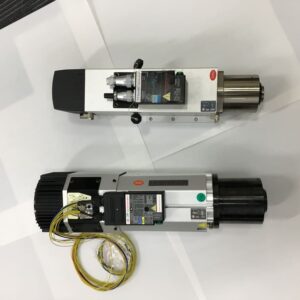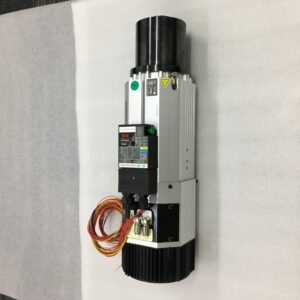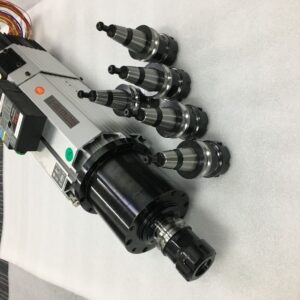Understanding the Key Elements of an ATC Spindle Motor: A Comprehensive Guide
Are you curious about the inner workings of ATC spindle motors and how they contribute to the efficiency of CNC machines? This comprehensive guide will delve into the essential components and features that make up these crucial elements of modern manufacturing. Whether you’re a seasoned machinist or just starting your journey in the world of CNC technology, this article will provide valuable insights into the intricate world of ATC spindle motors.
What Exactly is an ATC Spindle Motor?
An ATC (Automatic Tool Changer) spindle motor is a critical component in CNC machines, particularly in CNC routers and milling machines. It’s the heart of the machining process, responsible for rotating cutting tools at high speeds to shape and form materials with precision. But what sets an ATC spindle motor apart from standard spindles?
Why is the ATC Feature So Important in Modern CNC Machines?
The Automatic Tool Changer feature revolutionizes the efficiency of CNC operations. By allowing quick and automated tool changes, it significantly reduces downtime and increases productivity. But how does this impact overall manufacturing processes?

What Are the Core Components of an ATC Spindle Motor?
Understanding the anatomy of an ATC spindle motor is crucial for both operators and maintenance personnel. Let’s break down the key elements:
- Rotor and Stator: The powerhouse of the spindle
- Bearings: Precision components for smooth rotation
- Tool Holder: The interface between spindle and cutting tool
- Cooling System: Essential for maintaining optimal performance
- Encoder: For accurate speed and position control
Each of these components plays a vital role in the spindle’s performance and longevity. For instance, high-quality bearings are crucial for maintaining precision at high RPMs, while an efficient cooling system prevents overheating during extended operations.
Unable to render image
Key components of an ATC spindle motor
How Does the Cooling System in an ATC Spindle Motor Work?
Cooling is a critical aspect of spindle motor performance, especially in high-speed applications. There are two main types of cooling systems:
- Air-cooled spindles: Utilize ambient air for heat dissipation
- Water-cooled spindles: Use liquid coolant for more efficient temperature control
Each system has its advantages, and the choice often depends on the specific application and operating conditions. For example, water-cooled spindles are preferred in high-power, continuous operation scenarios due to their superior cooling efficiency.
What Role Does the Encoder Play in an ATC Spindle Motor?
The encoder is a crucial component for precise control of the spindle’s speed and position. It provides real-time feedback to the CNC controller, ensuring accurate tool positioning and speed regulation. This level of control is essential for maintaining tight tolerances and achieving high-quality surface finishes.
How Does Spindle Power Affect Performance?
Spindle power, typically measured in kilowatts (kW), is a key factor in determining the capabilities of a CNC machine. Higher power ratings generally allow for:
- Faster material removal rates
- Ability to machine harder materials
- Improved surface finish quality
However, it’s important to note that power isn’t everything. The right balance of power, speed, and torque is crucial for optimal performance across various applications.
What Are the Typical RPM Ranges for ATC Spindle Motors?
ATC spindle motors come in a wide range of speeds, typically from 6,000 to 60,000 RPM. The choice of RPM depends on several factors:
- Material being machined
- Tool diameter
- Desired surface finish
- Type of operation (roughing vs. finishing)
For instance, high-speed spindles operating at 30,000 RPM or higher are often used for precision work on smaller parts or when working with materials that require high cutting speeds.
How Does Torque Factor into ATC Spindle Motor Performance?
While high RPM is often emphasized, torque plays an equally important role in spindle performance. Torque determines the spindle’s ability to maintain cutting force, especially at lower speeds. This is particularly important for operations like:
- Heavy roughing cuts
- Machining tough materials
- Large diameter tooling
The ideal balance between speed and torque depends on the specific machining requirements of each job.

What Are the Benefits of VFD-Controlled ATC Spindle Motors?
Variable Frequency Drive (VFD) technology has revolutionized spindle motor control. VFDs offer several advantages:
- Precise speed control
- Improved energy efficiency
- Soft start capabilities
- Extended motor life
By allowing for fine-tuned speed adjustments, VFDs enable operators to optimize cutting parameters for each specific operation, resulting in improved part quality and tool life.
How Do ATC Spindle Motors Compare to Servo Motors in CNC Applications?
While both ATC spindle motors and servo motors are crucial in CNC machines, they serve different purposes:
- ATC Spindle Motors: Responsible for tool rotation and cutting action
- Servo Motors: Control axis movement and positioning
Understanding the interplay between these motor types is essential for achieving optimal machine performance. For example, the precision of servo motors in axis control complements the high-speed cutting capabilities of ATC spindle motors.

What Maintenance Practices Ensure Longevity of ATC Spindle Motors?
Proper maintenance is crucial for the longevity and performance of ATC spindle motors. Key practices include:
- Regular lubrication of bearings
- Monitoring and maintaining proper coolant levels
- Periodic alignment checks
- Vibration analysis for early problem detection
- Proper warm-up procedures before operation
Implementing a comprehensive maintenance schedule can significantly extend the life of your spindle motor and prevent costly downtime.In conclusion, ATC spindle motors are complex yet crucial components in modern CNC machinery. Understanding their key elements, from cooling systems to encoder functionality, is essential for anyone involved in CNC operations. By mastering the intricacies of these powerful motors, manufacturers can optimize their machining processes, improve product quality, and stay competitive in today’s fast-paced manufacturing landscape.Key takeaways:
- ATC spindle motors combine high-speed rotation with automated tool changing capabilities
- Proper cooling, whether air or water-based, is crucial for spindle performance and longevity
- Encoder technology ensures precise speed and position control
- The balance of power, speed, and torque is key to optimal machining results
- VFD control offers enhanced efficiency and flexibility in spindle operation
- Regular maintenance is essential for maximizing spindle life and performance
By keeping these factors in mind, CNC operators and manufacturers can make informed decisions about their spindle motor selection and maintenance, ultimately leading to improved productivity and quality in their machining operations.
- RicoCNC has a team of professionals who have been engaged in the design, production, sales, and maintenance of electro spindles for many years. Our company accepts the purchase of various types of CNC Spindles.
water-cooled CNC spindle motors
Edge banding machine spindle motors.
- If you need any CNC spindle, please contact us.

